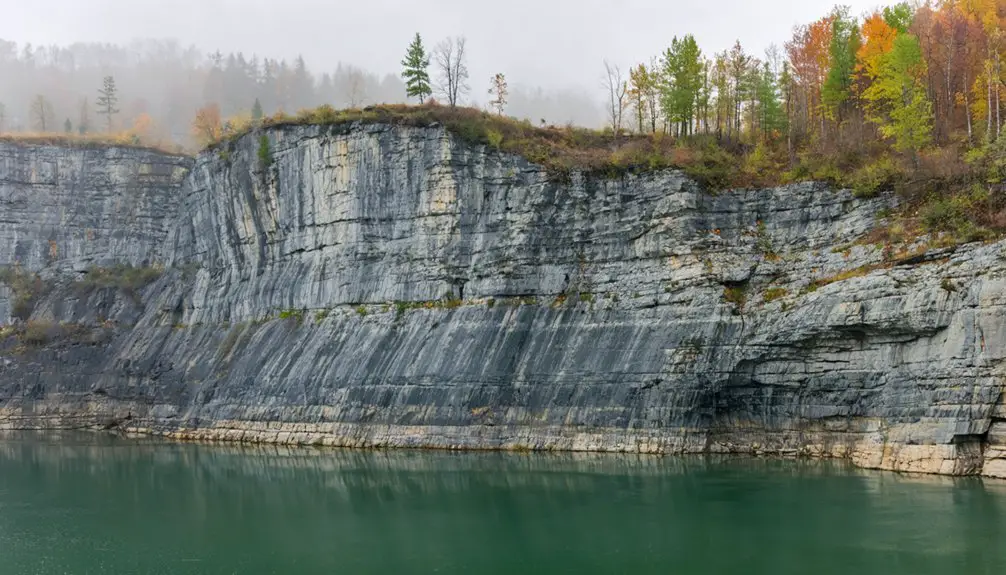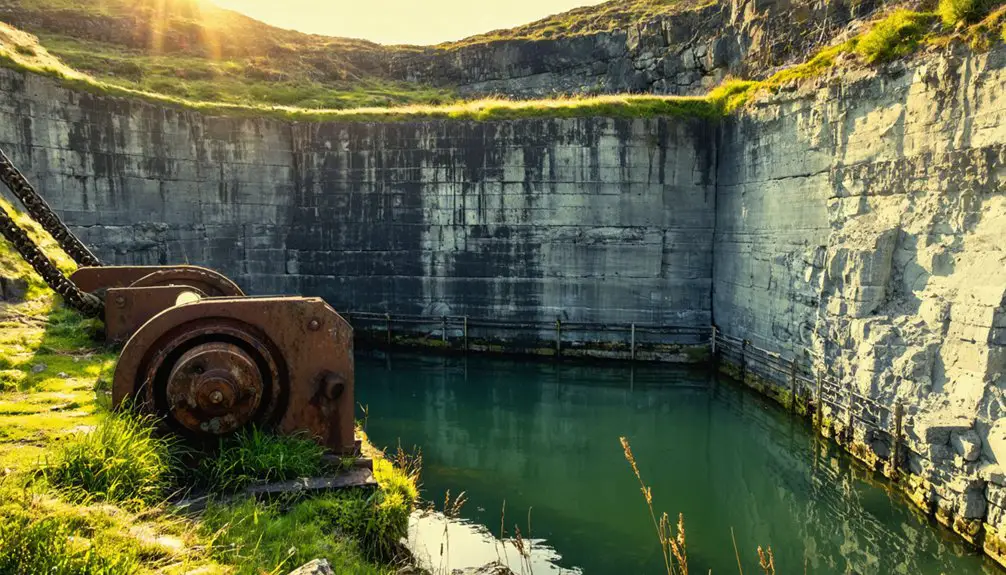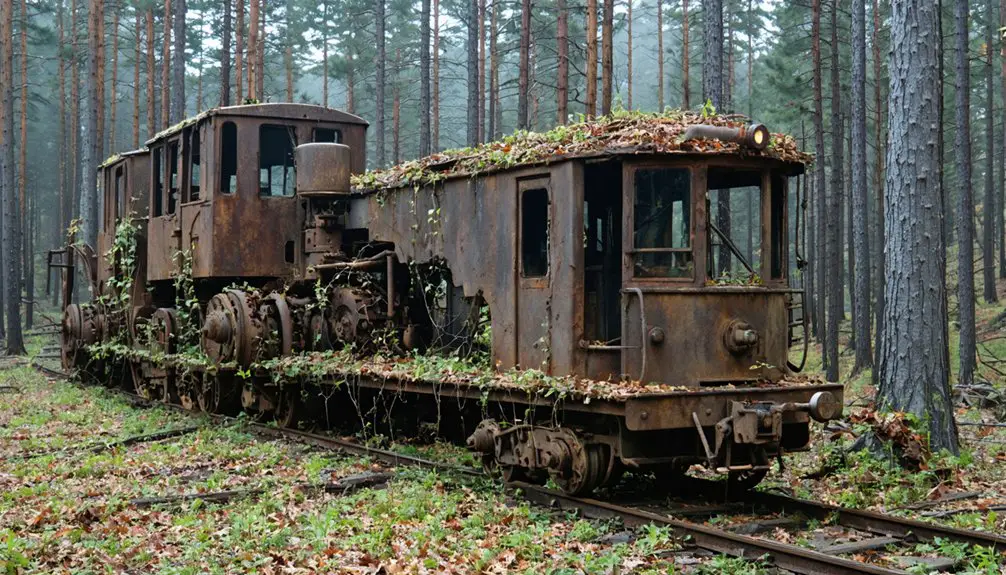You’ll find Crawford’s Quarry stretching 2.25 miles along Lake Huron’s shoreline in northern Michigan, where limestone mining operations began in 1898. The quarry evolved from temporary mining camps into a thriving industrial town after U.S. Steel’s 1920 acquisition, becoming the world’s largest limestone producer by 1930. Today, abandoned stone crushers, flooded quarry pits, and remnants of company housing tell tales of mysterious happenings and unexplained phenomena amid the ruins.
Key Takeaways
- Once a thriving limestone mining community, Crawfords Quarry transformed from temporary camps into permanent settlements built by immigrant miners.
- The quarry site spans 2.25 miles long and quarter-mile wide, now partially filled with lakes and reclaimed by nature.
- Abandoned structures, collapsed buildings, and flooded quarry pits remain as evidence of the area’s boom-and-bust mining history.
- Visitors report paranormal activities including ghostly whispers, spectral sightings, and unexplained phenomena near the abandoned structures.
- The site encompasses 7,000 acres, with inactive sections becoming natural habitats while 3,000 acres remain active for limestone mining.
The Rise and Fall of a Mining Town
When mining engineer Henry H. Hindshaw started evaluating limestone deposits in northeastern Michigan in 1909, he couldn’t have known he’d spark Crawford’s economy into existence.
You’ll find his initial drilling near Rogers City proved the limestone’s exceptional quality for industrial use, particularly for the Solvay Process Company.
By 1910, the Michigan Limestone and Chemical Company had organized, introducing modern mining techniques to extract some of the purest limestone in the region. The company’s headquarters established in Rogers City, Michigan became the center of operations. The quarry soon grew to become the world’s largest limestone producer by 1930.
Michigan Limestone revolutionized local mining, bringing advanced extraction methods to access the region’s premium limestone deposits.
The quarry’s strategic location on Lake Huron‘s shore made shipping effortless, while the high-grade limestone met significant demands for steel production, cement, and road building.
But like many single-industry towns, Crawford’s fortunes rose and fell with market demands.
Changes in industrial materials and fierce competition eventually led to the town’s decline, transforming it into the ghost town you’ll discover today.
A Journey Through Time: 1900-Present
You’ll find Crawford’s Quarry‘s transformation from ghost town to industrial hub began after its 1900 abandonment, when U.S. Steel’s Michigan Limestone Division purchased and renamed it “Calcite” in 1910.
Through World War II and beyond, the site evolved with technological advancements, expanding its limestone operations while adapting to changing market demands and environmental regulations. Much like the Salem Formation quarries of Indiana, the site became a major limestone producer.
Today’s Calcite operations continue within Rogers City’s limits, though the remnants of the original settlement serve as silent witnesses to its mining town origins. The site’s history traces back to when Francis Crawford Jr. established the first post office in 1864.
Early Mining Operations Period
The mining operations at Crawfords Quarry sprang to life in 1898 when surveyors Thomas Appleton and W.W. Stockley began mapping the area.
Within a year, you’d have seen impressive Phoenix Bridge Company structures spanning 1,400 feet, soaring 65-85 feet high to support essential mining infrastructure.
Mining techniques evolved rapidly as the Champion Mining Company extracted copper through four active shafts by 1902. Like Central Mine’s early success, the operation quickly reached impressive outputs of over 83,000 pounds of copper in its first season.
You’d have witnessed ore being “stamped” with iron plates and mixed with Lake Superior water, creating a 40% copper slurry ready for transport.
The community’s resilience showed through harsh winters as immigrant miners, many from Cornwall, transformed temporary camps into permanent settlements. Miners resided in simple boarding house rooms that cost one dollar monthly to rent.
Through ownership changes and lease negotiations, the mining town demonstrated remarkable adaptability, even as workers faced challenging conditions both underground and in their daily lives.
Industrial Rebirth Under Steel
Following the mining era’s decline, Michigan Limestone and Chemical Company breathed new life into Crawfords Quarry in 1910, launching large-scale limestone production by 1912.
You’d have witnessed an impressive transformation as the company built a complete industrial complex, including a processing factory, powerhouse, and harbor facilities with loading slips for Great Lakes freighters.
The quarry’s industrial growth accelerated when U.S. Steel acquired ownership in 1920. A feud with Rogers City over county seat status had previously divided the region in 1875.
You could’ve watched massive steam shovels extract limestone that would feed the hungry steel mills of Detroit, Cleveland, Gary, and South Chicago.
The operation’s 14-mile rail spur to the Detroit & Mackinac Railroad guaranteed efficient distribution, while the expanding market reach included agriculture, construction, and chemical industries.
Within two decades, the site became the world’s largest producer of limestone, showcasing its dominance in the industry.
Modern Ruins and Remnants
Walking through Crawfords Quarry today reveals a stark contrast to its industrial heyday, as nature slowly reclaims what was once the world’s largest limestone operation.
You’ll find the quarry’s massive scars stretching 2.25 miles long and quarter-mile wide, now partially filled with lakes that steam on cool mornings. Similar to many towns that emerged due to natural resources, Crawfords Quarry’s rise and eventual abandonment followed the familiar pattern of Michigan’s ghost towns. Like Hamblen, the town experienced a swift economic decline once its primary industry ceased operations.
For adventurous quarry exploration enthusiasts, the site offers several points of historical significance:
- Collapsed industrial structures atop gravel hills
- Flooded quarry pits creating new wetland ecosystems
- Ruins of early settlement foundations
- Off-road vehicle trails winding through the landscape
- Hidden remnants of machinery among overgrown vegetation
The area, now within Rogers City limits, stands as a symbol of Michigan’s industrial past.
While most original buildings are gone, the transformed landscape continues to attract visitors seeking both recreational opportunities and connections to the region’s mining heritage.
Limestone Legacy: U.S. Steel’s Impact
Since its acquisition of the quarry property in 1920, U.S. Steel transformed the local limestone industry into a world-class operation. By renaming it “Calcite” and implementing advanced quarry technology, they created the world’s largest limestone quarry right in Rogers City, Michigan.
U.S. Steel revolutionized Rogers City’s limestone industry in 1920, transforming a local quarry into the world’s largest operation at Calcite, Michigan.
You’ll find that U.S. Steel’s impact went far beyond just mining. They revitalized dying settlements by creating jobs and developing vital infrastructure.
Their innovative conveyor systems and port facilities at Calcite enabled efficient transportation across Lake Huron. Through careful geological planning and engineering, they’ve maintained limestone sustainability while supplying essential materials for steel production, concrete manufacturing, and construction projects throughout the Great Lakes region.
The company’s commitment to technological advancement and infrastructure development has secured the quarry’s position as a cornerstone of regional industrial growth.
The Big Cut: Geographic Features

The Big Cut stands as a striking indication to the scale of quarrying operations in Crawford’s former settlement. You’ll find this massive geological formation stretching 2.25 miles in length and reaching widths up to a quarter mile, creating a dramatic scar across Michigan’s landscape.
The quarry’s unique features include:
- A small lake that creates mysterious morning mists
- Abandoned ruins scattered among gravel hills
- Northwest-dipping sedimentary layers
- Dolomite and limestone geological formations
- Natural wetland environments forming in excavated areas
Within the Michigan Basin’s complex geology, you’ll discover how The Big Cut‘s quarry ecology has evolved.
The site’s transformed environment now showcases the interaction between industrial heritage and natural processes, where groundwater fills former excavation sites and new ecosystems emerge among the quarry’s dramatic walls.
Hidden Stories Behind the Ruins
As you walk the former grounds of Crawfords Quarry, you’ll encounter stark evidence of its industrial past in the two-mile-long quarry scars and scattered ruins that tell of abrupt abandonment around 1900.
Beyond the physical remnants, local folklore points to unexplained phenomena, with reports of ghostly figures and mysterious morning mists rising from the quarry lake.
These stories, documented by the Crawford County Historical Museum, add layers of intrigue to the site’s transformation from bustling limestone operation to ghost town, and finally to its resurrection as part of Rogers City.
Industrial Scars Still Visible
Looming concrete foundations and rusted machinery scattered across Crawfords Quarry tell a story of industrial might now frozen in time.
You’ll find a landscape permanently transformed by decades of limestone extraction, where quarry landscapes reveal deep excavated pits and stratified rock faces.
The industrial decay is evident in these haunting remnants:
- Abandoned stone crushers and conveyor system foundations
- The old 14-mile spur track route connecting to the Detroit & Mackinac Railroad
- Deteriorating harbor loading slips where lake freighters once docked
- Weathered steam locomotive tracks and dump car remains
- Former elevated viewing platforms overlooking the quarry’s expanse
These industrial scars paint a stark picture of the site’s role in powering America’s steel industry, while drainage channels and waste rock piles continue to shape the area’s watershed patterns.
Lives Left Behind
Behind Crawford’s Quarry‘s weathered ruins lies a complex tapestry of human stories, shaped by Francis Crawford Jr.’s 1864 limestone settlement and its later transformation into U.S. Steel’s Calcite operation in 1910.
You’ll find echoes of community resilience in the remnants of company housing where quarry workers raised their families, their daily lives revolving around the steady rhythm of mining operations.
Like neighboring Pere Cheney, the quarry settlement faced its share of hardships – forgotten narratives etched in moss-covered headstones and unmarked graves.
These stories interweave with local legends of curses, disease outbreaks, and social tensions that tested the fabric of frontier life.
Today, the abandoned structures and burial grounds stand as silent witnesses to the boom-and-bust cycle that ultimately scattered this once-thriving community to the winds.
Paranormal Echoes Remain Unexplained
Through the darkened ruins of Crawfords Quarry, unexplained phenomena have left investigators and visitors puzzled for generations.
You’ll encounter ghostly whispers echoing through dense woods, while spectral sightings of shadowy figures dart between crumbling foundations and abandoned railroad tracks.
The haunting presence manifests in various ways:
- Sudden temperature drops without natural explanation
- Unexplained touches and hair-pulling sensations
- Equipment malfunctions during paranormal investigations
- Disembodied voices and laughter near the ruins
- Mysterious orbs and blue mist sightings
Local folklore attributes these disturbances to a witch’s curse and Native American unrest, amplified by the quarry’s tragic history of disease and abandonment.
The isolated terrain, combined with scattered ritual remnants and unsettling cemetery proximity, continues to fuel paranormal activity reports.
Paranormal Tales From the Quarry
Since its abandonment in the early 20th century, Crawfords Quarry has earned a reputation as one of Michigan’s most haunted locations, with visitors reporting an array of unexplained phenomena.
You’ll encounter spectral sightings near the old mining pits, where shadowy figures dart between rusted equipment and mysterious lights dance in the darkness. These ghostly encounters often intensify at twilight, when disembodied voices echo through the quarry walls and unexplained footsteps follow visitors along abandoned paths.
Whether you’re exploring the quarry’s deepest pits or investigating its weathered structures, you might witness the phantom black dog that locals call the “Hellhound,” or catch glimpses of translucent miners in period clothing.
Cold spots, swirling mists, and electromagnetic disturbances add to the quarry’s reputation for supernatural activity.
Life in Crawford County’s Mining Era

When limestone deposits were discovered near Rogers City in 1909 by Henry H. Hindshaw, it transformed Crawford County into Michigan’s premier mining region.
By 1957, you’d find this area producing 76% of the state’s non-metallic minerals, bringing dramatic changes to local life.
Mining families faced these daily realities:
- Tough physical labor in both underground and open-pit mines
- Housing clustered around quarry sites for easy access to work
- Community services and shops built specifically for workers
- Seasonal work patterns depending on market demands
- Constant safety risks from dust exposure and mechanical operations
Life centered around Grayling, the county seat, where you’d find worker struggles balanced against economic opportunity.
The Michigan Central and Detroit & Charlevoix railroads connected these hardworking communities, while the port of Calcite shipped limestone across the Great Lakes, keeping the region’s lifeblood flowing.
Natural Transformation and Modern Usage
The Crawford Quarry’s landscape today bears little resemblance to its early mining days.
You’ll find a sprawling 7,000-acre site where natural ecology gradually reclaims inactive sections, while modern industrial balance continues in the 3,000 actively mined acres.
Pioneer plants now colonize abandoned pits, creating new habitats where limestone extraction once dominated.
The quarry maintains its industrial significance, having yielded over 750 million tonnes of limestone with century-more reserves remaining.
You’ll see how advanced mining technology serves modern construction needs while minimizing environmental impact.
The site’s transformation extends beyond industry – you can explore visitor trails, including winter snowmobile routes, and witness how former mining areas now serve as outdoor classrooms for geology and ecology studies.
Preserving Michigan’s Mining Heritage
Michigan’s commitment to preserving its mining heritage spans multiple government levels, with federal and state initiatives working in tandem to protect these historic sites.
You’ll find robust preservation efforts through programs like the Save America’s Treasures Grant and the Great Lakes Restoration Initiative, ensuring these crucial pieces of history aren’t lost to time.
Key elements of heritage preservation include:
- Digital archiving of 650+ historic drill records dating back to 1899
- Interactive mapping systems for geographic visualization
- Community-driven preservation planning
- Partnership between federal, state, and local entities
- Long-term monitoring spanning 20+ years
Mining archives at Michigan Tech serve dual purposes – they’re essential for modern mineral exploration while documenting the evolution of mining technologies.
Through these efforts, you’re witnessing a unique blend of environmental stewardship and cultural preservation that keeps Michigan’s mining history alive.
Frequently Asked Questions
What Happened to the Original Quarry Equipment and Machinery After Abandonment?
You’d be surprised how quickly quarry machinery vanishes – instead of equipment restoration, the valuable machines were systematically disassembled and sold off, leaving only scattered iron remnants behind.
Were There Any Notable Accidents or Deaths During Quarry Operations?
You’ll find limited records of quarry safety incidents, with only one documented case involving John McIntyre in 1889. While worker fatalities were common in quarries then, specific death records aren’t available.
What Specific Types of Limestone and Minerals Were Extracted Here?
Time reveals all treasures, and you’ll find they mainly extracted Rogers City limestone, a high-purity calcite variety from the Dundee formation, alongside mineral-rich brines containing bromine and calcium-magnesium chloride compounds.
Did Native Americans Use This Area Before the Quarry’s Establishment?
You’ll find strong evidence of Native American settlements in this area, with numerous burial mounds and copper artifacts proving historical significance through extensive tool-making, hunting, and ceremonial activities before quarry operations began.
How Many People Lived in Crawfords Quarry During Its Peak Population?
You’ll find that exact peak population records for Crawfords Quarry weren’t directly documented, but regional data suggests several thousand people likely lived near the quarry during its industrial heyday mid-1900s.
References
- https://www.upnorthvoice.com/news/crawford-news/2018/11/crawford-county-ghost-towns/
- https://migenweb.org/presque_isle/Ghosttowns/crawford.html
- https://www.nailhed.com/2015/10/making-cut.html
- https://99wfmk.com/gay-michigan-2020/
- https://99wfmk.com/hamblen-holbrook/
- https://en.wikipedia.org/wiki/Michigan_Limestone_and_Chemical_Company
- https://kids.kiddle.co/Michigan_Limestone_and_Chemical_Company
- https://www.michigan.gov/-/media/Project/Websites/egle/Documents/Programs/GRMD/Catalog/07/GIMDL-PU16.PDF?rev=c7504b553afa4ecc9dd9bf47a6a879fb
- https://www.upnorthvoice.com/features/2019/10/how-did-crawford-burial-mounds-get-here/
- https://www.wikiwand.com/en/articles/Michigan_Limestone_and_Chemical_Company


